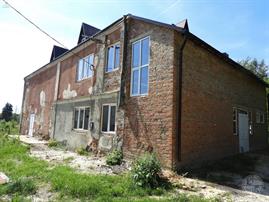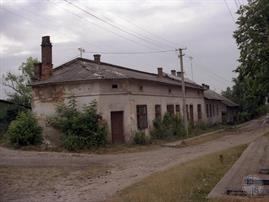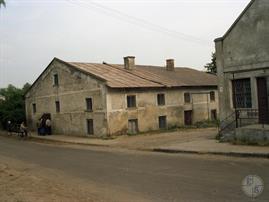Maheriv
Lviv district, Lviv region
Year - Total Population - Jews
1880 - 2,812 - 1,138
1900 - 3,158 - 1,322
1921 - 2,473 - 600
1880 - 2,812 - 1,138
1900 - 3,158 - 1,322
1921 - 2,473 - 600
Sources:
- Pinkas Hakehillot Polin: Encyclopedia of Jewish Communities, Poland, Volume II, page 306-307, published by Yad Vashem, Jerusalem. Translated by Jerrold Landau, JewishGen, Inc.
Photo:
- Boris Khaimovich, Eva Maria Kraiss. Center for Jewish art, Maheriv (Magerуw, Magerov)
- Pinkas Hakehillot Polin: Encyclopedia of Jewish Communities, Poland, Volume II, page 306-307, published by Yad Vashem, Jerusalem. Translated by Jerrold Landau, JewishGen, Inc.
Photo:
- Boris Khaimovich, Eva Maria Kraiss. Center for Jewish art, Maheriv (Magerуw, Magerov)
Magierуw (ukr. Maheriv, Магерів) was founded in 1591 as a private city by the nobleman Jan Magier, from whom the name of the settlement was derived. In the writ of rights granted by the nobleman to the city, it is stated clearly that Jews “who are a devious and lowly nation, who fight against Christianity” are forbidden to live in Magierуw. The nobleman also commanded his heirs to conduct themselves as he did. In 1567, the army of the Hungarian nobleman Rбkуczi was defeated near Magierуw by the Polish commander Czarnecki.
Despite the aforementioned directive, there were already Jews in Magierуw in 1629. From that year, until the tribulations of Tach VeTat [The Chmielnicki uprisings and disturbances in 1648-1649], they only owned one house in the city. Apparently, approximately 70 Jews lived there at the beginning of the 18th century. From the beginning of the existence of the Jewish settlement until near the end of the 19th century, the Jews earned their livelihood primarily from commerce and tavern keeping, as well as from some trades.
At the end of the 19th century, Jews also worked as employees. They were employed primarily in three trades: the manufacture of brooms, in which approximately 80 people worked in their homes; the manufacture of brushes from pig bristles, as well as buttons and cuffs – a sector that primarily employed women, and the products of which were sold in Vienna. Among the various trades, Jews worked in tailoring and shoemaking. There were also several bakers and butchers.
Jews of Magierуw began to immigrate to the United States already at the end of the 19th century.
At the beginning of the 20th century, the tradesmen organized themselves and set up some sort of “organization” that primarily fulfilled the roles of traditional organizations such as “Bikur Cholim” (tending to the sick), “Linat Tzedek” (tending to the sick overnight) and the like, rather than the roles of a trade union.
Prior to the First World War, there was a fortress-like synagogue, a Beis Midrash, and an adjacent kloiz in Magierуw.
From among the known rabbis of Magierуw, there was Rabbi Yosef Alter Epsztajn, who served in the rabbinate of the town from 1870-1894. He moved from there to Lazeshchyna. His son, Rabbi Gershon, took over his seat, and served in the rabbinate from 1894-1920. From 1920-125, Rabbi Naftali-Hertz Bombach served as the rabbi. He then moved from Magierуw to serve as the rabbinical judge in Sambor. The final rabbi of Magierуw was Rabbi Rappaport.
Admorim, mainly of the Belz dynasty, also lived in Magierуw. They were: Rabbi Aryeh-Leib Rokach the son of Rabbi Yehoshua, who move to Rawa Ruska after the First World War, and his son Nachum-Aharon who settled in Lwуw, where he became known as a preacher.
At the beginning of the First World War, when Magierуw was conquered by the Russian Army, most of the Jews left and hid in villages. When they returned to their city, still during the time of the Russian occupation, they found that all their houses had been burnt down, with the exception of the synagogue and three other houses. It should be noted that not one Christian house was damaged at that time.
Despite the aforementioned directive, there were already Jews in Magierуw in 1629. From that year, until the tribulations of Tach VeTat [The Chmielnicki uprisings and disturbances in 1648-1649], they only owned one house in the city. Apparently, approximately 70 Jews lived there at the beginning of the 18th century. From the beginning of the existence of the Jewish settlement until near the end of the 19th century, the Jews earned their livelihood primarily from commerce and tavern keeping, as well as from some trades.
At the end of the 19th century, Jews also worked as employees. They were employed primarily in three trades: the manufacture of brooms, in which approximately 80 people worked in their homes; the manufacture of brushes from pig bristles, as well as buttons and cuffs – a sector that primarily employed women, and the products of which were sold in Vienna. Among the various trades, Jews worked in tailoring and shoemaking. There were also several bakers and butchers.
Jews of Magierуw began to immigrate to the United States already at the end of the 19th century.
At the beginning of the 20th century, the tradesmen organized themselves and set up some sort of “organization” that primarily fulfilled the roles of traditional organizations such as “Bikur Cholim” (tending to the sick), “Linat Tzedek” (tending to the sick overnight) and the like, rather than the roles of a trade union.
Prior to the First World War, there was a fortress-like synagogue, a Beis Midrash, and an adjacent kloiz in Magierуw.
From among the known rabbis of Magierуw, there was Rabbi Yosef Alter Epsztajn, who served in the rabbinate of the town from 1870-1894. He moved from there to Lazeshchyna. His son, Rabbi Gershon, took over his seat, and served in the rabbinate from 1894-1920. From 1920-125, Rabbi Naftali-Hertz Bombach served as the rabbi. He then moved from Magierуw to serve as the rabbinical judge in Sambor. The final rabbi of Magierуw was Rabbi Rappaport.
Admorim, mainly of the Belz dynasty, also lived in Magierуw. They were: Rabbi Aryeh-Leib Rokach the son of Rabbi Yehoshua, who move to Rawa Ruska after the First World War, and his son Nachum-Aharon who settled in Lwуw, where he became known as a preacher.
At the beginning of the First World War, when Magierуw was conquered by the Russian Army, most of the Jews left and hid in villages. When they returned to their city, still during the time of the Russian occupation, they found that all their houses had been burnt down, with the exception of the synagogue and three other houses. It should be noted that not one Christian house was damaged at that time.
After the war, the Jews of Magierуw received assistance from their fellow natives in the United States as well as from the JOINT. With the assistance money, the Beis Midrash was rebuilt, and a new fence was built around the cemetery, whose fence had been broken during the time of the Russian occupation. The brush manufacturing came to an end during the time of Polish rule, for it could not withstand the competition of manufacturing in that sector in other places. In place of this, the Jews of Magierуw, like those of Rawa Ruska, began to work in the making of furs for Jewish contractors in Rawa Ruska. Many families earned their livelihoods from this sector.
A Zionist organization was set up in Magierуw during that era. The party with the greatest influence from among the Zionist streams was Hitachdut. In the elections for the Zionist congresses from 1931, they received more than two thirds of all the votes. The only youth movement active in Magierуw was Gordonia. Several Jews of Magierуw belonged to the Communist Party.
When the names of the streets of the town were set in 1934, two of the six main streets of the town received the names of Jews: the streets named for Berek Joselowicz, and for Dr. Leon Reich.
In the communal elections of 1928, in which 137 people voted, the Zionists received four mandates, the Belz Hassidim – three, and the those not affiliated with a party – one. With the assistance of donations from fellow natives in the United States, the community set up assistance for Passover needs, and other assistance activities. In 1939, a communal committee to help the poor was set up. A joint committee was organized in the public school of Magierуw, consisting of Jews and gentiles, to ensure that any needy child received a glass of milk and piece of bread daily.
There were two Jewish supplementary schools in Magierуw: a Hebrew school and a Beis Yaakov. The Y. L. Peretz Library was involved in cultural activities. Several Jewish Communists were among those active in the library. A drama club operated under the auspices of Beis Yaakov. There was also a Jewish sports organization, which was especially involved with basketball.
During the 1930s, the Ukrainians accused the Jews of Magierуw of collaboration with the Poles. The Jewish peddlers stopped making the rounds in the villages out of fear of the Ukrainians. In 1936, a Jewish village family was attacked. The husband and wife were seriously injured, and brought to the hospital in Їуіkiew (Zhovkva).
With the German invasion of Poland on September 1, 1939, Jewish refugees from western Poland arrived in Magierуw and were assisted by the local community. In the middle of September, units of the German Army arrived in course of their eastward advance. The German soldiers snatched Jews of Magierуw for forced labor, and tortured them.
Soldiers of the Red Army entered Magierуw on September 22, 1939. The Jews were forced to abandon their previous sources of livelihood, especially in the arena of commerce. Therefore, during the first months of Soviet rule, the Jews of Magierуw suffered from economic straits. However, the Jews gradually became involved in government civil service and the network of cooperatives. In 1940, arrests of Jews took place under economic pretexts.
The communal institutions disbanded, but religious life was not disturbed, albeit it functioned in a non-official fashion. With the beginning of the German invasion of the Soviet Union on June 22, 1941, a great panic overtook the Jewish community of Magierуw, due to the fact that it was close to the border. The Jews of Magierуw were witness to the weakening of the Soviet front, and there was no opportunity to escape eastward.
A Zionist organization was set up in Magierуw during that era. The party with the greatest influence from among the Zionist streams was Hitachdut. In the elections for the Zionist congresses from 1931, they received more than two thirds of all the votes. The only youth movement active in Magierуw was Gordonia. Several Jews of Magierуw belonged to the Communist Party.
When the names of the streets of the town were set in 1934, two of the six main streets of the town received the names of Jews: the streets named for Berek Joselowicz, and for Dr. Leon Reich.
In the communal elections of 1928, in which 137 people voted, the Zionists received four mandates, the Belz Hassidim – three, and the those not affiliated with a party – one. With the assistance of donations from fellow natives in the United States, the community set up assistance for Passover needs, and other assistance activities. In 1939, a communal committee to help the poor was set up. A joint committee was organized in the public school of Magierуw, consisting of Jews and gentiles, to ensure that any needy child received a glass of milk and piece of bread daily.
There were two Jewish supplementary schools in Magierуw: a Hebrew school and a Beis Yaakov. The Y. L. Peretz Library was involved in cultural activities. Several Jewish Communists were among those active in the library. A drama club operated under the auspices of Beis Yaakov. There was also a Jewish sports organization, which was especially involved with basketball.
During the 1930s, the Ukrainians accused the Jews of Magierуw of collaboration with the Poles. The Jewish peddlers stopped making the rounds in the villages out of fear of the Ukrainians. In 1936, a Jewish village family was attacked. The husband and wife were seriously injured, and brought to the hospital in Їуіkiew (Zhovkva).
With the German invasion of Poland on September 1, 1939, Jewish refugees from western Poland arrived in Magierуw and were assisted by the local community. In the middle of September, units of the German Army arrived in course of their eastward advance. The German soldiers snatched Jews of Magierуw for forced labor, and tortured them.
Soldiers of the Red Army entered Magierуw on September 22, 1939. The Jews were forced to abandon their previous sources of livelihood, especially in the arena of commerce. Therefore, during the first months of Soviet rule, the Jews of Magierуw suffered from economic straits. However, the Jews gradually became involved in government civil service and the network of cooperatives. In 1940, arrests of Jews took place under economic pretexts.
The communal institutions disbanded, but religious life was not disturbed, albeit it functioned in a non-official fashion. With the beginning of the German invasion of the Soviet Union on June 22, 1941, a great panic overtook the Jewish community of Magierуw, due to the fact that it was close to the border. The Jews of Magierуw were witness to the weakening of the Soviet front, and there was no opportunity to escape eastward.
Magierуw was conquered by the Germans already at the end of June 1941. Acts of torture against the Jews by the German soldiers and Ukrainian police began immediately. Jewish men were snatched for forced labor, especially in repairing bridges and roads that were damaged by the battles.
The autumn months of 1941-1942 were accompanied by administrative and economic decrees: the obligation to wear the mark of shame, the restriction of movement, the ban on purchasing food products in the city market, regular pillage of property, and the broadening of forced labor. Hunger and illness took many victims.
On Passover 5702 (1942), S.S. units arrived in Magierуw from Rawa Ruska, and began to round up the Jews. Some of the members of the community were murdered on the spot. Others were deported to Rawa Ruska, from where they were taken to be killed in the Belzec Camp. The Admor Rabbi Nachum-Aharon Rokach was among the victims.
The local population also participated in the hunt for those in hiding. Only groups of professionals still remained in Magierуw, but they too were deported to Rawa Ruska in September 1942, where they shared the fate of the remainder of that community.
The autumn months of 1941-1942 were accompanied by administrative and economic decrees: the obligation to wear the mark of shame, the restriction of movement, the ban on purchasing food products in the city market, regular pillage of property, and the broadening of forced labor. Hunger and illness took many victims.
On Passover 5702 (1942), S.S. units arrived in Magierуw from Rawa Ruska, and began to round up the Jews. Some of the members of the community were murdered on the spot. Others were deported to Rawa Ruska, from where they were taken to be killed in the Belzec Camp. The Admor Rabbi Nachum-Aharon Rokach was among the victims.
The local population also participated in the hunt for those in hiding. Only groups of professionals still remained in Magierуw, but they too were deported to Rawa Ruska in September 1942, where they shared the fate of the remainder of that community.

- Home
- Shtetls
- Vinnytsia region
- Volyn region
- Dnipro region
- Donetsk region
- Zhytomyr region
- Zakarpattia region
- Zaporizhzhia region
- Ivano-Frankivsk region
- Kyiv region
- Kropyvnytskyi region
- Luhansk region
- Lviv region
- Mykolayiv region
- Odessa region
- Poltava region
- Rivne region
- Sumy region
- Ternopil region
- Kharkiv region
- Kherson region
- Khmelnytskyi region
- Chernihiv region
- Chernivtsi region
- Cherkasy region
- Crimea
- Synagogues
- Cemeteries
- Objects & guides
- Old photos
- History
- Contact
Jewish towns of Ukraine
Jewish towns of Ukraine
My shtetl
My shtetl
Donate



